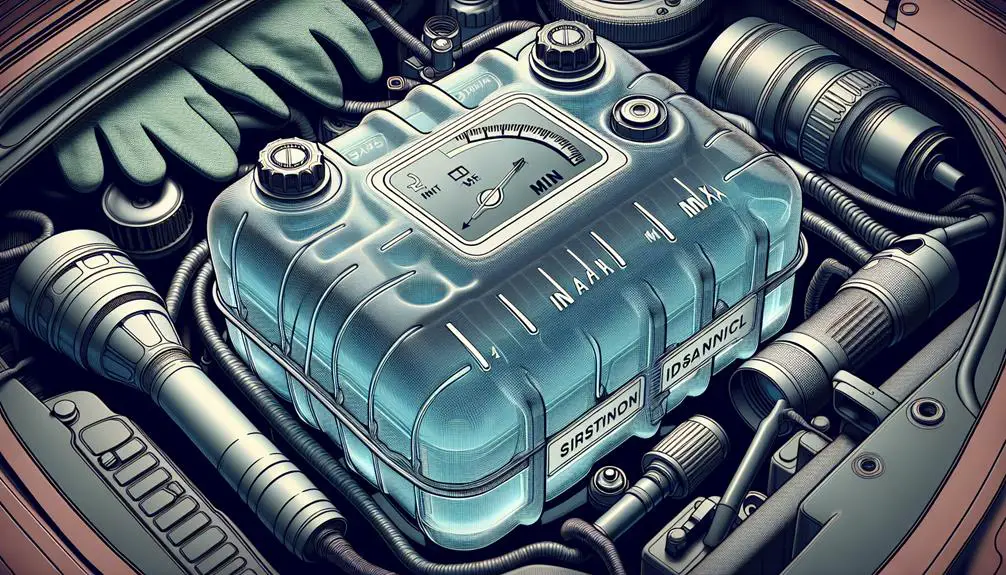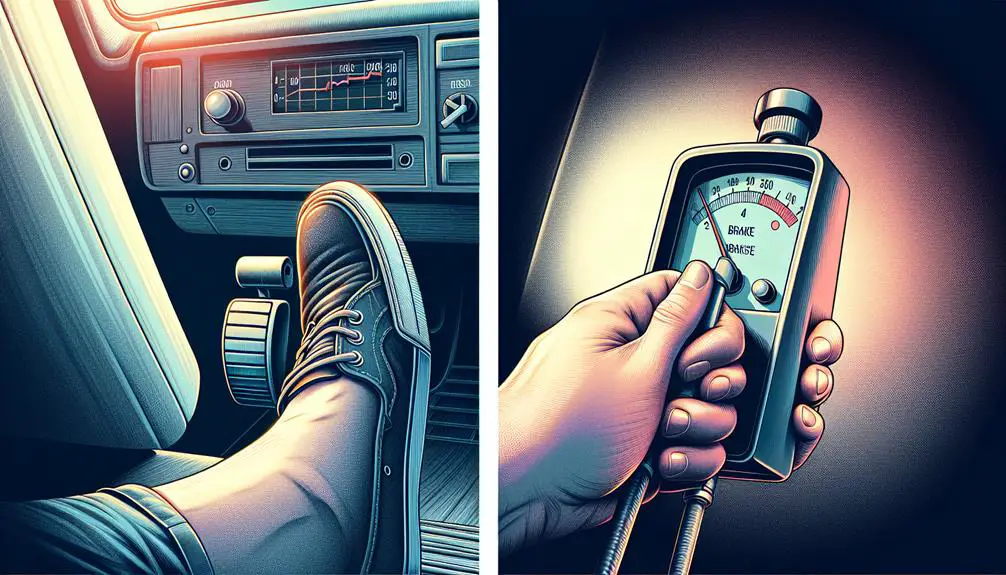To fix a low brake pedal, there are several steps you can take:
- Check the brake fluid level.
- Inspect for leaks in the brake lines.
- Examine the condition of the brake pads.
- Bleed the brake system.
These steps will help identify and address the issues causing the low brake pedal.
Inspect Brake Fluid Levels

Ensure, verify your brake fluid levels to make certain they're not the culprit behind your low brake pedal. It's a straightforward process that you can do in your driveway. Pop open your car's hood and locate the brake fluid reservoir. It's usually near the back of the engine bay, mounted on or near the master cylinder.
You'll see markers on the side of the reservoir indicating 'Min' and 'Max' levels. If the fluid's below the 'Min' line, that's a red flag. Low brake fluid can lead to a spongy or low brake pedal, as it directly affects the hydraulic pressure in your brake system.
If you find the fluid level's low, top it off with the correct type of brake fluid specified in your car's manual. But remember, brake fluid doesn't just disappear; a low level might hint at a leak somewhere else in the system. After topping off, press the brake pedal a few times and recheck the level to verify it stays stable.
This simple check can give you insight into your brake system's health and potentially save you from a more serious issue down the road.
Check for Brake Line Leaks
Inspecting for brake line leaks is crucial, as even a small leak can greatly impact your braking system's efficiency. A compromised brake line can lead to a spongy or low brake pedal, posing a serious safety risk. Here's how you can check for leaks:
- Visual Inspection: Start by visually inspecting all brake lines and hoses. Look for any signs of wetness or corrosion. Brake fluid is typically clear to slightly yellowish and may leave a white residue when it dries.
- Check Fittings and Connections: Make sure all fittings and connections are tight and secure. Sometimes, a leak isn't from the line itself but from where it connects to the brake calipers or the master cylinder.
- Press the Brake Pedal: With the engine off, press the brake pedal firmly. If there's a leak, the pressure can cause fluid to seep out, making it easier to identify the leak's location.
- Use a Flashlight: Shine a flashlight along the brake lines, especially in areas that are hard to see. This can help you spot any leaks that weren't immediately obvious during the initial inspection.
Finding and addressing brake line leaks early can prevent more serious issues down the road.
Replace Worn Brake Pads

Replacing worn brake pads is an essential step in restoring your braking system's effectiveness and ensuring your safety on the road. Worn pads can lead to a low brake pedal, making it harder to stop your vehicle swiftly. Here's a straightforward guide to help you through the process.
| Step | Tool Needed | Action |
|---|---|---|
| 1 | Jack and Jack Stands | Lift and secure your vehicle |
| 2 | Wrench Set | Remove the wheel to access the brake caliper |
| 3 | C-Clamp or Caliper Tool | Retract the caliper piston |
| 4 | Allen or Torx Bit | Remove the caliper and old pads |
| 5 | Wire Brush | Clean the caliper mounting surface |
Once you've removed the old pads, it's essential to compare them with the new ones to ensure a proper fit. Don't forget to check the brake pad thickness and look for any uneven wear patterns, which could indicate issues with the caliper. Installing the new pads is essentially the reverse of removal. After they're in place, reassemble the caliper and wheel, then lower your vehicle gently. Remember, the first few stops might feel a bit soft as the pads bed in, but you'll soon notice a significant improvement in your brake pedal's responsiveness.
Bleed the Brake System
After installing new brake pads, it's important to bleed the brake system to make sure no air is trapped, impacting your car's stopping ability. Air in the brake lines can greatly reduce brake performance, making your pedal feel spongy or low. Here's how you can effectively bleed your brake system to guarantee peak performance:
- Locate the Bleeder Valve: Start by locating the bleeder valve on each brake caliper. It's usually a small nipple-like protrusion with a place for a wrench and a cap on top to keep dirt out.
- Prepare the Brake Fluid: Before you start, make sure you have the correct type of brake fluid for your vehicle. Open the master cylinder reservoir and fill it to the full mark with fresh fluid.
- Bleed Each Wheel: Starting with the wheel furthest from the master cylinder, attach a clear tube to the bleeder valve, leading the other end into a container partially filled with brake fluid. Have a helper press the brake pedal several times and then hold it down. Open the valve to let air and fluid out, then close it before your helper releases the pedal. Repeat until no air bubbles appear in the fluid.
- Refill the Master Cylinder: Throughout the process, keep an eye on the brake fluid level in the master cylinder. Top it off as necessary to prevent air from being drawn into the system.
Test Brake Pedal Responsiveness

Once you've bled the brake system, test the pedal's responsiveness by firmly pressing down to feel for any sponginess or delay. This step's important as it'll tell you if there's still air trapped in the lines or if other issues are at play. You're looking for a solid, immediate response when you press the pedal. If it feels mushy or sinks towards the floor, you've got more work to do.
Here's how to nail this test. Sit in the driver's seat, start the engine, and let it idle to make sure the power brake booster is active. Without moving the vehicle, press the brake pedal several times. Each press should feel consistent, and the pedal should return to its original position swiftly. If it doesn't, or if the pedal feels different with each press, you likely have air in the system or maybe a leak.
Conclusion
To sum up, fixing a low brake pedal starts with checking your brake fluid levels and inspecting for any leaks in the brake lines.
You'll also need to replace worn brake pads to ensure proper braking performance.
Don't forget to bleed the brake system to remove any air pockets that could affect pedal responsiveness.
After these steps, test your brake pedal's responsiveness.
With a bit of effort and attention, you'll have your braking system working perfectly in no time.